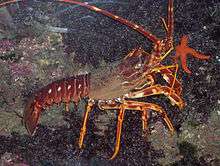Palinurus elephas
| Palinurus elephas | |
|---|---|
 | |
| Scientific classification | |
| Kingdom: | Animalia |
| Phylum: | Arthropoda |
| Subphylum: | Crustacea |
| Class: | Malacostraca |
| Order: | Decapoda |
| Family: | Palinuridae |
| Genus: | Palinurus |
| Species: | P. elephas |
| Binomial name | |
| Palinurus elephas (Fabricius, 1787) | |
| Synonyms | |
|
Palinurus vulgaris Latreille, 1803 | |
Palinurus elephas is a spiny lobster, which is commonly caught in the Mediterranean Sea. Its common names include European spiny lobster,[1] crayfish or cray (in Ireland), common spiny lobster,[2] Mediterranean lobster[3] and red lobster.[4]
Distribution and habitat
Palinurus elephas is a common species of spiny lobster, found in the eastern Atlantic Ocean, from southern Norway to Morocco and the Azores,[5] and in the Mediterranean Sea, except its eastern extremes.[2] It lives on rocky exposed coasts below the intertidal zone,[1] mainly at depths of 20 to 70 metres (66 to 230 ft).
Description
_walking_-_Gijon_Aquarium_-_2015-07-02.webm.jpg)
P. elephas may reach up to 60 cm (24 in) long,[1] although rarely longer than 40 cm (16 in),[2] and usually 25–30 centimetres or 10–12 inches.[6] Few achieve their maximum weight of several kilograms.[5]
The adults are reddish-brown with yellow spots. The carapace is slightly compressed and lacks lateral ridges. It is covered with forward pointing spines, with the supraorbital spines prominent. The antennae are very heavy and spiny. Their flagellum is tapering and is even longer than the body. The first walking leg (pereopod) is provided with subchela (the distal end of a limb developed as a prehensile structure). The fourth segment (merus) of this leg has a characteristic row of spines.[6]
Reproduction
The breeding season is in September and October, with the female brooding the reddish eggs. These eggs hatch about six months later in the spring as flattened, leaf-shaped, planktonic larvae (phyllosoma larvae).[5][6]
Diet
It is nocturnal and feeds on small worms, crabs or dead animals, hiding in rock crevices or caves during the day.[3]
Uses
It is a much sought-after delicacy and is widely caught for food around the Mediterranean Sea, mostly with lobster pots, and is also caught less intensively off the Atlantic Coasts of Ireland, Portugal, France and England.[2] There are also small fisheries for this species on the west coast of Scotland, employing tangle nets or lobster pots.
References
| External identifiers for Palinurus elephas | |
|---|---|
| Encyclopedia of Life | 1022068 |
| ITIS | 97657 |
| NCBI | 198232 |
| WoRMS | 107703 |
| Also found in: WAZA, MarLIN | |
- 1 2 3 A. Jackson & C. Marshall (January 29, 2007). "European spiny lobster, Palinurus elephas: basic information". Marine Life Information Network: Biology and Sensitivity Key Information Sub-programme.
- 1 2 3 4 Lipke B. Holthuis (1991). "Palinurus elephas". FAO Species Catalogue, Volume 13. Marine Lobsters of the World. FAO Fisheries Synopsis No. 125. Food and Agriculture Organization. pp. 119–120. ISBN 92-5-103027-8.
- 1 2 "Palinurus elephas (Mediterranean lobster)". Malawi Cichlid Homepage. Retrieved June 3, 2011.
- ↑ "Exploitation models of the red lobster Palinurus elephas in the Mediterranean fisheries of Spain and Tunisia". FAO COPEMED. Food and Agriculture Organization. May 31, 2005. Retrieved June 3, 2011.
- 1 2 3 Peter Hayward, Tony Nelson-Smith & Chris Shields (1996). Sea Shore of Britain and Europe. Collins Pocket Guides. HarperCollins. ISBN 0-00-219955-6.
- 1 2 3 P. J. Hayward, M. J. Isaac, P. Makings, J. Moyse, E. Naylor & G. Smaldon (1996). "Crustaceans (Phylum Crustacea)". In P. J. Hayward & J. S. Ryland. Handbook of the Marine Fauna of North-West Europe. Oxford University Press. pp. 289–461. ISBN 0-19-854055-8.
External links
- Palinurus elephas (Fabricius, 1787), SeaLifeBase
 Media related to Palinurus elephas at Wikimedia Commons
Media related to Palinurus elephas at Wikimedia Commons